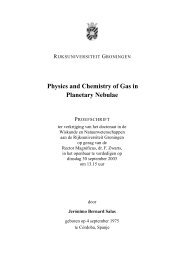TRACING ABUNDANCES IN GALAXIES WITH THE SPITZER ...
TRACING ABUNDANCES IN GALAXIES WITH THE SPITZER ...
TRACING ABUNDANCES IN GALAXIES WITH THE SPITZER ...
You also want an ePaper? Increase the reach of your titles
YUMPU automatically turns print PDFs into web optimized ePapers that Google loves.
Oxygen Our values for the total oxygen abundance usually agree to within<br />
a factor of two of those in the literature, and often within 50%. For the one<br />
case where we can compare to the study in the literature with published ionic<br />
abundances (Wang & Liu, 2007), the ionic abundance of O + is higher by 50% in<br />
this work than in that study, but the ionic abundance of O +2 (the dominant ion)<br />
is lower by 10% than in that study, and the total elemental oxygen abundances<br />
agree within 10%. The IR data show that for one object (PNG000.7+03.2), the<br />
O +3 contributes significantly (∼30%) to the total oxygen abundance, and thus<br />
optical studies must either use an uncertain ICF or underestimate the total oxygen<br />
abundance in this object.<br />
Considering that we employ more observed stages of ionization than purely op-<br />
tical studies and also that we derive ionic abundances for the major contributors to<br />
the total elemental abundances for argon, neon, and sulfur from IR lines (which are<br />
less sensitive to CHβ and Te than abundances from optical lines), our GBPNe abun-<br />
dances for these elements are more accurate than previous studies. Our GBPNe<br />
abundance of oxygen, however, should be of similar accuracy to previous optical<br />
studies because we must rely on optical lines for the dominant ionization stages,<br />
but we make a slight improvement by measuring or placing an upper limit on the<br />
abundance from the O +3 infrared line.<br />
Comparison of Mean Abundances with the Literature<br />
We compare our mean Bulge abundance from the GBPNe to mean Bulge abun-<br />
dances derived from other GBPNe abundance studies, red giant stars, and H II<br />
regions in Table 3.12. The mean abundances of our GBPNe generally agree well<br />
with mean abundances of GBPNe determined from the optical studies. The mean<br />
neon abundances are the most discrepant, with ours being a factor of ∼2 higher<br />
than those in the literature (reasons for such a discrepancy are given in §3.6.1). Our<br />
83













